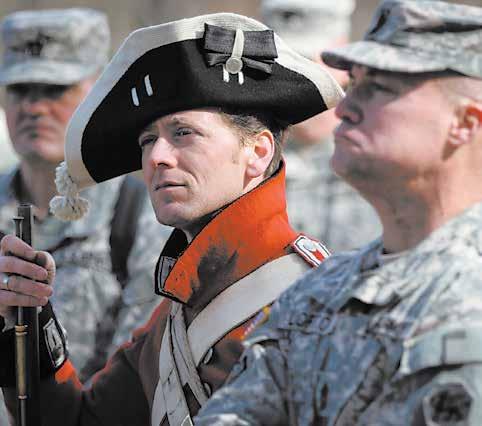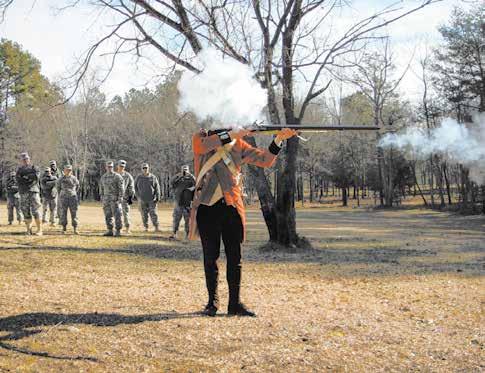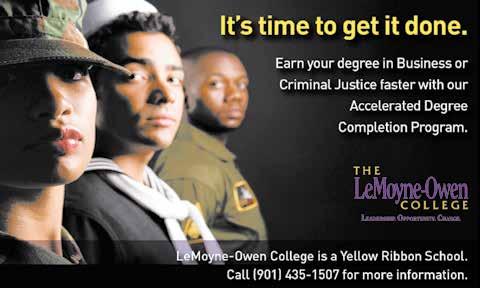
5 minute read
Senior Leaders Experience History on Revolutionary War Battlefield Echo Company Incorporates Reserve Component
Senior Leaders Experience History on Revolutionary War Battlefield
By Sgt. Ken Scar
Advertisement
108th Training Command (IET) Public Affairs
COWPENS, S.C. — Senior leadership of the U.S. Army Reserve’s 108th Training Command (IET) spent a sunny winter day walking in the footsteps of Infantry Soldiers from the Revolutionary War in the grassy meadows and shady sweet gum forest of the Cowpens National Battlefield in South Carolina Feb. 7. The visit was part of a training event designed to teach leadership skills through the triumphs and failures of fellow Soldiers from the past.
“It’s important for us to remind ourselves of the reason we exist, which is to fight and win the nation’s wars,” said Maj. Sean Healy, assistant operations officer for the 108th Training Command (IET), who helped to organize the event. “Having the opportunity to walk in the footsteps of Soldiers past offers a reminder of what it’s like to be in the heat of battle.”
The Battle of Cowpens happened Jan. 17, 1781. It was a decisive victory for the Continental Army forces under Brig. Gen. Daniel Morgan. His wing of the Continental Army was being chased across South Carolina by a much larger British element led by Lt. Col. Banastre Tarleton. Morgan decided to stop and make a stand in the pastureland known as the Cowpens, where he could use the unique landscape to provide cover and concealment and cut off avenues of retreat while capitalizing on his knowledge of his opponent to draw the British forces into the area and give them a false sense of victory.
Revolutionary War re-enactor Christopher Ruff, curator for the National Museum of the U.S. Army Reserve (wearing a replica uniform of the British Army’s 7th Fusiliers), leads a group of senior leadership from the 108th Training Command across a field on the Cowpens National Battlefield Feb. 8, 2015. The command took the trip to the site to learn first-hand the tactics and techniques used by the American forces to win the battle, in which they were greatly outnumbered. Photo by Sgt. Ken Scar, 108th Training Command (IET), Public Affairs
Morgan’s strategy proved to be ingenious. The battle was over in less than an hour, and was a complete victory for the Patriot force. More than 800 British Troops were killed, wounded or captured. The Americans suffered less than 100 casualties.
Guided by U.S. Army Col. (retired) Dr. John Boyd, director of the Office of Army Reserve History, the Soldiers of the 108th split into two units and played out pinnacle moments from the battle, lining up across the tall grass to advance and charge on each other across the exact ground Morgan and Tarleton clashed on 234 years earlier.
“I love the aspect of [Brig. Gen. Morgan] himself. Here was a leader who understood the capabilities and capacities of his Soldiers, and the type of Soldiers they were,” said Boyd. “For example his employment of militia, his use of skirmishers ... the man had such a great knowledge base in terms of what his capabilities were. To translate that into modern terms: he knew how to deploy his weapon systems. It was just plain gutsy leadership.”
Revolutionary War re-enactor Christopher Ruff, curator for the National Museum of the U.S. Army Reserve, participated in the maneuvers dressed in a reproduction


Revolutionary War re-enactor Christopher Ruff, curator for the National Museum of the U.S. Army Reserve, stands with senior leadership of the 108th Training Command (IET) on the Cowpens National Battlefield, Feb. 8, 2015. The command was conducting a “staff ride” training exercise to learn techniques and tactics used by both British and American forces during the Revolutionary War. Photo by Sgt. Ken Scar, 108th Training Command (IET), Public Affairs
British Infantry Uniform from the time, complete with period musket, lending a splash of vibrant red to the proceedings.
“This is a battleground that appears much as it did. When Soldiers can come out here and walk the grounds it adds so much more than any kind of class room setting,” he said, adding that Brig. Gen. Morgan’s tactics during the battle offer a prime example of good leadership.
“In this battle in particular, the American command structure knew their men intimately, which is something that our modern officers need to emulate,” he said. “Morgan knew his men, he knew their capabilities, and this is something that is extremely important for our Soldiers to understand.”
Fighters in the Revolutionary War could not hope to make accurate shots until they were right up on each other. The muskets they used were inaccurate beyond 80 yards, and even then they were difficult to fire and reload. Skirmishes regularly ended with hand-to-hand combat with bayonets.
The difference between winning and losing under such brutal conditions was made in the men who led, said Boyd.
“To win, you had to have a leader who had a plan that was inspirational enough to motivate you to fight it out,” he said. “Morgan said ‘Don’t shoot until you see the whites of their eyes’ right here on this battlefield.”
Boyd said he hopes playing out Morgan’s tactics in victory will help the 108th’s leaders be more effective if they ever find themselves on battlefields of their own.
“This is more than just battle and tactics in 1780. I hope they learn an appreciation of leadership and the human element,” said Boyd. “I hope that they integrate what they learn on this battlefield, and transfer the lessons to today’s Army. My objective as a military historian is; if one thing a Soldier learns here helps them make a judicious decision when deployed that perhaps saves a life, then my position is justified.”
“I think we were able to illustrate some important lessons learned here that are applicable in today’s context,” reflected Healy. “As we know; if we don’t learn from history we’re doomed to repeat it.”


Revolutionary War re-enactor Christopher Ruff, curator for the National Museum of the U.S. Army Reserve, demonstrates the firing of a .75-caliber British infantry musket for senior leadership of the 108th Training Command on the Cowpens National Battlefield, Feb. 8, 2015. Photo by Sgt. Ken Scar, 108th Training Command (IET), Public Affairs











